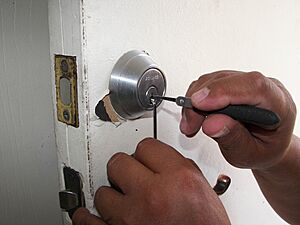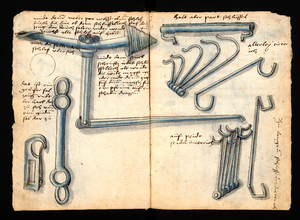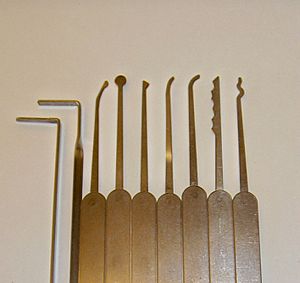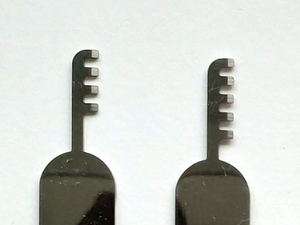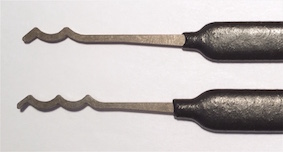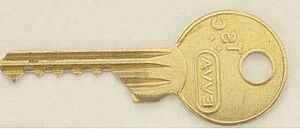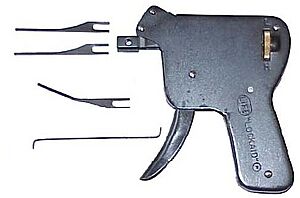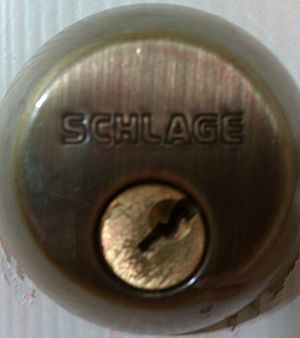Lock picking facts for kids
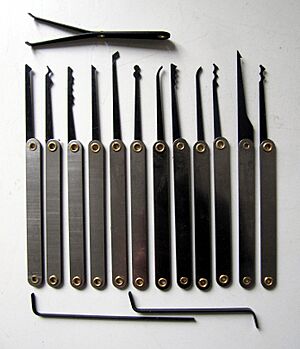
Lock picking is the skill of opening a lock without its original key. This is done by carefully moving the small parts inside the lock.
While some people might think of lock picking in movies, it's a very important skill for professional locksmithing. Many people also enjoy it as a fun and challenging hobby, often called "locksport". It's like solving a puzzle!
In some places, owning lock picking tools is not allowed for most people. But in many other countries, you can own them as long as you don't plan to use them for anything wrong. Always remember to follow the rules where you live.
A Look Back in Time
Locks have been around for a very long time to keep things safe. People have probably tried to open them without a key for just as long! A famous locksmith named Alfred Charles Hobbs once said in the 1800s that people who wanted to break into things knew a lot about lock picking even before locksmiths talked about it.
Lock picking has also been a hobby for many smart people throughout history. King Louis XVI of France, who lived from 1754 to 1793, loved designing and opening locks. Even the famous scientist Richard Feynman picked locks for fun in the 1940s. Students at MIT (a famous university) also learned lock picking as part of their adventures.
Since 1997, lock picking has grown into an organized hobby with competitions. This is called "locksport", and it even has its own international group.
Tools of the Trade
There are many different tools used for lock picking, each designed for a specific type of lock or method.
Skeleton Keys
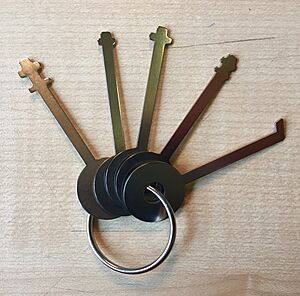
A skeleton key is a special tool used for warded locks. These locks have obstacles inside called "wards." A skeleton key is shaped simply, allowing it to get past these wards. It only needs to move the very end part of the lock to open it. The other parts of a regular key for these locks are just there to tell different keys apart.
Picking Pin Tumbler Locks
Pin tumbler locks are very common. They have tiny pins inside that need to be lined up perfectly to open. Here are some tools used for them:
Comb Picks
Comb picks are designed to push all the pins in a lock up at once. This creates a clear path, allowing the lock to open.
Tension Wrenches
A tension wrench, also called a torsion wrench, is a key tool for picking pin tumbler locks. It applies a gentle turning force to the lock's core. This force holds any pins you've already set in place. Once all the pins are in the correct spot, the tension wrench helps turn the core to open the lock. There are different types, some for the bottom of the keyhole and some for the top.
Half-Diamond Picks
This pick is shaped like a small triangle. It's very useful for picking individual pins one by one. It can also be used for a faster method called "raking." Most pick sets include a few half-diamond picks.
Hook Picks
Hook picks look like a small hook. They are great for feeling and setting individual pins. Many professional lock pickers find this to be their most important tool. There are many different sizes and shapes of hooks.
Ball Picks
Ball picks have a rounded tip, either a half-circle or a full circle. They are often used for opening wafer locks.
Rake Picks
Rake picks, like the snake rake, are used to quickly "rake" across all the pins. You slide the pick in and out rapidly. This makes the pins bounce until they briefly line up, allowing the lock to open. Raking often works well on simpler locks and requires less precise skill than picking pins one by one.
Decoder Picks
A decoder pick is a special key that can change its shape. You put it into the lock, and then you can adjust its parts. This not only opens the lock but also helps you figure out the exact shape needed to cut a new key for it.
Bump Keys
A bump key is a simple way to open many pin locks. It's a key cut with all its peaks at the lowest possible point. You insert it into the lock and then tap it sharply with a hammer while applying a slight turning force. This tapping makes only the top pins jump up, leaving the bottom pins in place. For a brief moment, the lock can turn. Some newer, high-security locks have special features to prevent bumping.
Picking Wafer Tumbler Locks
Wafer tumbler locks are another common type, often found in desks or cabinets.
Jigglers or Try-Out Keys
Many wafer tumbler locks can be opened with a set of "jigglers" or "try-out keys." These are shaped to quickly manipulate the wafers inside. You can also use regular pin-tumbler picks on them.
Pick Guns
A pick gun, or snap gun, is a tool with a trigger. When you pull the trigger, it sends a quick burst of energy to the pins inside the lock. This makes the pins jump, just like with a bump key. For a short moment, the lock can turn. There are also electric versions that vibrate the pins.
Tubular Lock Picks
A tubular lock pick is a special tool for tubular pin tumbler locks. These locks have a round keyhole. The tool is inserted and turned, pushing down the pins one by one until the lock opens. This can happen very quickly. Some tubular lock picks can also "decode" the lock. This means they can tell a locksmith the exact shape needed to cut a new key, so the lock doesn't have to be replaced.
How Locks Stay Secure
The story of locks is like a friendly competition between lock makers and lock pickers. As pickers find new ways to open locks, inventors create even more secure designs!
Today, many standard pin tumbler locks use special features to prevent picking. These include tricky shapes inside the keyhole and "security pins." These pins might be shaped like spools or mushrooms. They are designed to make a picker think a pin is set when it's not, making the lock harder to open.
Playing by the Rules
Lock picking is a fascinating skill and a fun hobby. However, it's super important to remember that you should only ever pick locks that you own or have clear permission to open. Using lock picking tools on someone else's property without their permission is wrong and can lead to serious trouble. Always be respectful of other people's belongings and follow the laws where you live.
See also
- Hot-wiring
- Physical security
- Safe-cracking
- Security
- Lock bumping


